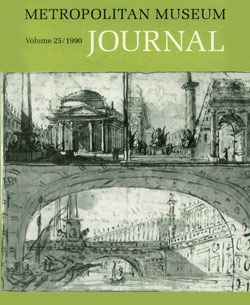Kosode with Scenes from Nō Plays
Not on view
In the late Edo period, kosode (“small-sleeved” robes) with this type of decorative scheme—dense landscape patterns accompanied by scenes alluding to traditional Japanese literature—conveyed an aristocratic flavor and were popular among women of the samurai class. The back of this robe features motifs that allude to three Nō plays. At the lower center, a colorful feather robe, fishing rod, and creel recall The Feather Mantle (Hagoromo), a play about a fisherman who finds a celestial being’s feather robe on a pine branch at Miho Beach. The divinity performs a dance to retrieve her robe and then ascends to heaven.
Near the seam of the left sleeve are a helmet, crossed arrows, and plum trees that recall The Quiver (Ebira). In this play, a warrior of the Genji clan, Kajiwara Kagesue (1162–1200), performs bravely in battle against the Heike near the Ikuta River (near modern Kobe), with a plum branch in his quiver.
Lady Shizuka at Yoshino (Yoshino Shizuka) is represented at the seam of the right sleeve by an eboshi court hat, a fan, and a drum in a stage-prop structure surrounded by blossoming cherry trees. In this play, the famous twelfth-century warrior Minamoto no Yoshitsune angers his powerful brother Yoritomo and is forced to flee. His lover, Shizuka, uses a seductive dance to distract his enemies, allowing him to reach safety on Mt. Yoshino.
Due to rights restrictions, this image cannot be enlarged, viewed at full screen, or downloaded.


